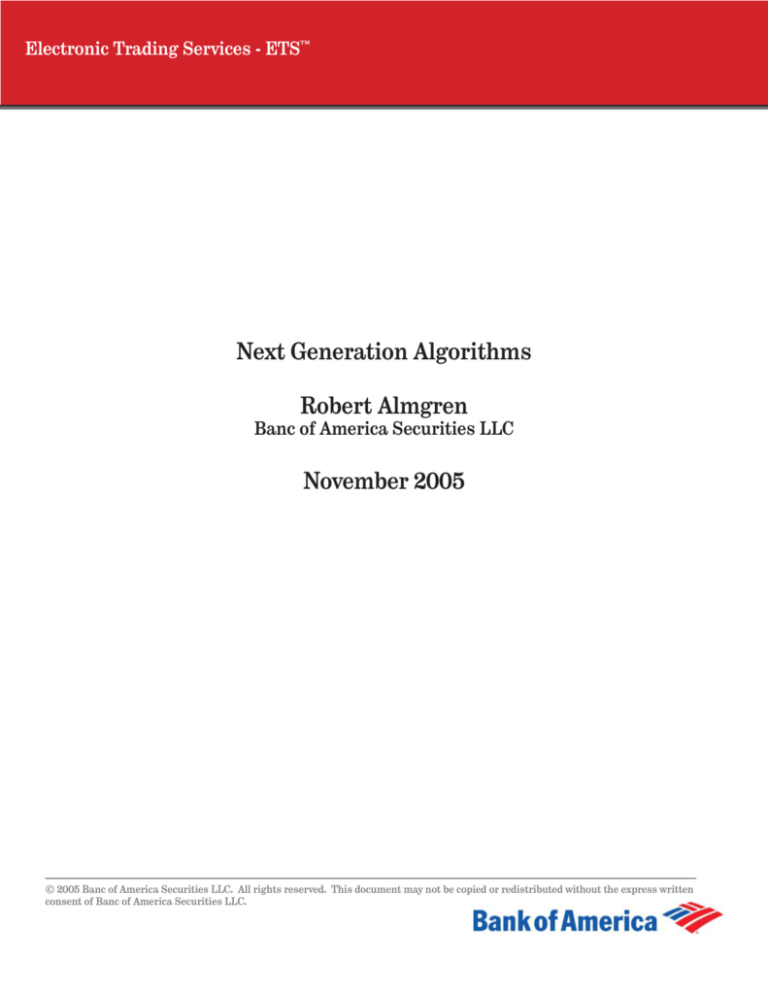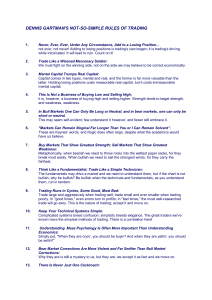
Electronic Trading Services - ETS™
Next Generation Algorithms
Robert Almgren
Banc of America Securities LLC
November 2005
© 2005 Banc of America Securities LLC. All rights reserved. This document may not be copied or redistributed without the express written
consent of Banc of America Securities LLC.
Electronic Trading Services - ETS™
Algorithmic trading means the execution of trade orders using computers, with or without
active human involvement. It represents a large and growing fraction of total order flow for
equities and other asset classes.
One advantage of using algorithmic trading is increased efficiency. Using a computer to
handle “routine’’ orders, a human trader can concentrate his or her effort on the “difficult’’
orders, effectively managing a higher total volume of orders than would be possible without
computer help.
A more subtle advantage is better execution. The computer can slice the original order into
many more pieces than the most attentive human. It can precisely follow given parameters
that describe the chosen tradeoff between cost and risk.
The difficulties associated with algorithmic trading stem from the fundamental fact
that trading is a human activity, and that computers do not have common sense. Some
parameters of execution that can be easily explained to a human are very difficult to specify
in computer code. For example, in an illiquid name, some tradeoff must be specified
between the cost of market impact versus the penalty attached to unexecuted shares.
At Banc of America Securities, our approach to these difficulties is to advance one step at a
time, building on existing algorithms and technology infrastructure.
Three Generations
1.
“First generation” algorithms are the currently existing ones. They assume that
market flow is smooth and predictable.
2. “Second generation” algorithms are currently in development, for application to
small-cap and other thinly traded stocks. They model the variations in market
volume, to trade only when counterparties are present. They use the techniques
of statistics and econometrics, so they require a certain minimum level of market
activity. Below we characterize the range of stocks to which these methods can apply.
3. “Third generation” algorithms will eventually use methods of psychology and game
theory to trade even the thinnest assets.
This white paper describes the underpinnings of second generation algorithms.
2.
Electronic Trading Services - ETS™
Individual Market Cap
1T
28−Jul−2005
Market Cap ($)
XOM
MSFT
IBM
100B HD
WYE
BR
HOT
TRB
ACS
SIAL
NFG
4.42B
10B
1B
CPRT
OVNT
KSWS
SCHN
AOS
REGN
BIOS
PNFP
253M
100M
Value Remaining ($)
15
0
x 10
500
1000
1500
2000
2500
3000
12
28−Jul−2005
Total value: 13.8T
10
11.2T
5
0
2.43T
86.5B
0
500
1000
1500
2000
2500
3000
Figure 1: Individual and cumulative market cap of Russell 3000® stocks. The new algorithms apply
to the shaded range, adding about $2.4 trillion to the available investment universe.
Source: Produced by BAS from Russell 3000® and MarketQA data.
3.
Trades per day
Electronic Trading Services - ETS™
10
5
10
4
10
3
10
2
10
1
10,000 trades/day
100 trades/day
0
500
1000
1500
2000
2500
3000
Figure 2: Average number of trades per day for Russell 3000®
Source: Produced by BAS from Russell 3000® and NYSE TAQ data.
In Figure 1 we characterize the range of stocks to which these algorithms will extend the
applicability of algorithmic trading. The universe shown is the Russell 3000® index, sorted
into decreasing order by market capitalization (available float, as of July 28, 2005). The top
500 stocks are extremely large and are well handled by existing algorithms. We intend to
cover about the next 2000, numbers 500 through 2500. Thus SIAL is the largest stock we
consider, BIOS the smallest.
In terms of the cumulative market cap (lower panel of Figure 1), the total value of the Russell
3000® is $13.8 trillion. Of that, the top 500 names together make up $11.2 trillion, or about
81%. The next 2000 add about $2.43 trillion of additional available investment, about 22%
additional. The remaining 500 names contain only $85.5 billion and are neglected.
We may also characterize the activity level of the stocks by the average number of trades
per day, as shown in Figure 2. For stocks that trade fewer than about 100 times per day,
statistics are not an adequate tool for good execution and we will have to wait for the third
generation algorithms. Most of the middle 2000 of the Russell 3000® meet this criterion,
with some outliers. There is no significant upper limit on the number of trades per day that
can be handled.
4.
Electronic Trading Services - ETS™
What is special about small-cap?
The distinguishing feature of small-cap stocks is irregular trade activity, as shown in Figure
3. In these pictures, we count the number of trade events (ignoring the share size, as
discussed below) in 15-minute bins through the day, for each of five consecutive days. The
result is one curve per day showing the intraday profiles. We do this for IBM as a typical
large cap stock, for SIAL at the top of our target range, and BIOS at the bottom.
For a typical large-cap stock (IBM), the profiles for different days are close together (within
a factor of two). First-generation algorithms replace the volume profile by its day-to-day
average. For such stocks, this is an acceptable approximation though not optimal. Even for
a large-cap stock, there are occasional outliers: on the morning of Oct 25, IBM announced
a 20¢ per share dividend, which caused a tremendous spike in trading activity. First
generation algorithms would ignore this activity.
For medium- and small-cap stocks (SIAL and BIOS), the day-to-day fluctuation is much more
significant, and cannot be ignored. The algorithm must incorporate some model for this
fluctuation, so as to submit trades only when counterparty market volume is present. There
are many statistical techniques available for modeling such fluctuations.
Modeling approaches
There are two general approaches to modeling the intraday fluctuation of some quantity
such as trade activity:
■ One may divide the trading day into bins, and count the number of shares or the number of
events in each bin. One would then look for the statistics of these binned quantities, such as
the variance of the count in each bin, and the serial correlation from the value in one bin to the
next.
If the bins are too large, then the time resolution is too coarse. If the bins are too small, then
the statistical fluctuation is too severe; many bins in fact have zero volume. In addition, the
bin value is not available until the end of the bin; this is a serious deficiency for real-time
monitoring.
■ Alternatively, one may construct a continuous-time indicator that updates its estimate of
market activity on each individual trade. The statistical and analytical techniques required are
somewhat more sophisticated, but the time resolution is much better.
Figure 4 shows a comparison.
5.
Electronic Trading Services - ETS™
IBM
Oct 24
Oct 25
Oct 26
Oct 27
Oct 28
1000
500
0
0900
1000
1100
1200
1300
1400
1500
300 SIAL
1600
Oct 24
Oct 25
Oct 26
Oct 27
Oct 28
200
100
0
0900
30
20
1000
1100
1200
1300
1400
1500
1600
BIOS
Oct 24
Oct 25
Oct 26
Oct 27
Oct 28
10
0
0900
1000
1100
1200
1300
1400
1500
1600
Figure 3: Number of trades in 15-minute buckets for a large, a medium, and a small stock. For largecap stocks, this value is well represented by its mean. Small-cap stocks are characterized by extreme
fluctuation: the average gives a very poor estimate of the value at any particular moment.
Source: Produced by BAS from NYSE TAQ data.
6.
Electronic Trading Services - ETS™
In Figure 4, the upper panel shows each trade with its price. The lower panel shows two
estimates of market activity:
■ The blue line is a prototype continuous-time indicator that estimates market activity in trades
per minute, based on a running average of the time interval between successive trades.
■ The gray bars are a more traditional estimate of activity: the number of shares per unit time,
measured on bins. (The bin widths are adjusted according to an average volume profile, but the
number of trades has been adjusted to give a rate in terms of true clock time.)
Thus two differences are being illustrated: the effect of binning, and the distinction between
trades and shares. For this trading day, shares and trades contain roughly the same
information.
Around 1 PM there is a sudden burst of trading activity, shown by the jump upwards of the
blue line, a high bin value, and a price move. But by the time the binned signal is available,
the activity is already moving back downwards. In fact, the bin immediately following the
high bin is no different from the average. An algorithm that bases its trading activity in
each bin on the activity level in the previous bin would completely miss the event.
The continuous indicator is more stable than the bin values during the oscillations in the
morning, and it reacts rapidly to the spike at 1 PM. By the time the bin value is available
to the trading algorithm, the continuous indicator is already heading downward. A trading
algorithm based on this indicator would have increased its order submission rate during the
spike.
Figure 5 illustrates that when the number of trades per minute, and the number of shares
per minute are different, the number of trades is the more economically meaningful
quantity. For CPRT on July 28, large share volumes are recorded around 12 PM and 12:30
PM, but the trade activity does not increase and the price does not move. These large
share volumes are likely associated with large block trades, in which it would not have been
possible to participate. An algorithm based on counting numbers of trade events rather
than shares would quite properly decline to increase its submission rate. (Of course if these
blocks are followed by increased activity, the algorithm would respond to that.)
Figure 6 shows the same data for IBM on October 24, 2005. Both indicators capture the
burst visible in Figure 3.
The significance of studying trade arrival times is reinforced by a recent academic
literature on the dynamics of the intervals between subsequent trades, starting with
the Autoregressive Conditional Duration model of Robert Engle and Jeffrey Russell
[Econometrica 66 (1998) 1127–1162].
7.
Electronic Trading Services - ETS™
66
Price
65.5
65
64.5
64
1000
1100
1200
1300
1400
1500
1600
1000
1100
1200
1300
1400
1500
1600
Shares and Trades
20
15
10
5
0
Figure 4: Comparison of bin-based volume measure and a prototype continuoustime indicator, for
SIAL on July 28, 2005. The bin value is available only at the end of the bin. The upper panel shows
each trade through the day (vertical axis is price). There is a spike and enhanced volatility around
1 PM. The lower panel is the same as Figure 4; both the binned and the continuous rate indicator
track the trade volatility. The bars are shares per unit time (with an arbitrary scale factor), the line is
trades per minute.
Source: Produced by BAS from NYSE TAQ data.
8.
Electronic Trading Services - ETS™
24.9
Price
24.8
24.7
24.6
24.5
24.4
1000
1100
1200
1300
1400
1500
1600
1000
1100
1200
1300
1400
1500
1600
Shares and Trades
8
6
4
2
0
Figure 5: Same as Figure 4, but for CPRT, also on July 28, 2005. Some individual large trades come
through near 12 PM and 12:30 PM, as indicated by the high bars for share volume. But these trades
do not move the continuous-time indicator which only counts number of trades. The price is flat during that interval, suggesting that market activity should be considered “low”.
Source: Produced by BAS from NYSE TAQ data.
9.
Electronic Trading Services - ETS™
84
Price
83.5
83
82.5
1000
1100
1200
1300
1400
1500
1600
1000
1100
1200
1300
1400
1500
1600
Shares and Trades
150
100
50
0
Figure 6: Same as previous, for IBM on October 25, 2005 (compare Figure 3). The algorithm captures
the burst of activity associated with the dividend announcment at 10:30 AM, which happens to be
divided between two bins.
Source: Produced by BAS from NYSE TAQ data.
10.
Electronic Trading Services - ETS™
Empirical analysis
The most reasonable sounding theories must be checked by empirical analysis. A subject of
ongoing research is to use BAS’ large historical database of orders to determine the leading
components of market impact. Figure 7 shows an example. A buy order for 64,000 shares of
BXP was entered at 10:33 AM on May 19, 2005 and was executed across most of the day. The
black dots and the superimposed green curve show a classic arrival price trajectory, in which
shares are sold rapidly at the beginning to reduce the volatility exposure, and more slowly at
the end to minimize market impact.
Optimal trajectories
If we have a perfect statistical understanding of market activity, how do we translate
this into an algorithmic trading trajectory? Figure 8 shows one example solution. The rate
of trading at any particular time (in practice this will be the shares submitted in the next
fifteen minutes) depends both on the number of shares remaining to execute in the program,
and on the current level of market activity. If the market is not capable of absorbing any
significant number of shares, then the algorithm will wait until counterparties are present.
Remaining questions
Several aspects are still in active research, to be solved as soon as the new algorithm moves
into production and customer use:
■ How does the impact and execution quality of a given size order depend on the market activity,
as measured by trade rate or other indicator? This will be answered by historical analysis of
past orders.
■ Can other stocks in the same sector or indices be used to anticipate volume in the stock of
interest?
■ What is the proper way to handle the chance of non-execution? These algorithms do not execute
until volume is present, and there is a chance such volume will not be present before the end of
the day. This is an especially delicate issue for pairs trading or long-short portfolios that must
remain cash-neutral.
■ What are the proper benchmarks? We strongly advocate arrival price over VWAP, since it better
corresponds to the decision price at which the trade was undertaken.
11.
Electronic Trading Services - ETS™
7
x 10
4
2005−05−19 BXP
Shares remaining
6
5
4
3
2
1
0
292.2 min, 16.5% hist, 15.4% today
1100
1200
1100
1200
1300
1400
1500
1300
1400
1500
Time of day
69
68.8
Price
68.6
68.4
68.2
68
67.8
67.6
Time of day
Figure 7: A historical order, to be used for market impact computation. In the upper panel, the black
dots and the superimposed green curve show the number of shares remaining to execute. The red
and blue curves show market background activity, scaled to match the order flow.
Source: Produced by BAS from internal and NYSE TAQ data.
12.
Electronic Trading Services - ETS™
Shares held x(t)
Trade rate v(t)
Market volume w(t)
Figure 8: An example optimal trajectory, based on a simulation. Upper panel is number of shares
remaining to execute. Middle panel is current rate of execution. Bottom panel is instantaneous
market rate. The trade rate depends both on the number of shares remaining and on the current
activity level, rather than simple on number of shares remaining as in current models.
Source: Produced by BAS from simulated data.
13.
Electronic Trading Services - ETS™
The material contained herein is for informational purposes only, and is not a product of the Banc of America Securities LLC
(“BAS”) research department. The commentary has been prepared by the Electronic Trading Services group of BAS, which
provides trading services and solutions for the securities industry. The material is not intended to rate or recommend any
security or any type of strategy or service for trading any security. BAS may offer the types of trading systems or strategies
mentioned in this material and may compete with the services, systems and markets of others that may be mentioned herein.
This report therefore may not be independent from the proprietary interests of BAS, which may conflict with your interests.
Any opinions expressed in this commentary are those of the author, who is a member or the Electronic Trading Services
group, and may differ from or be contrary to the opinions expressed by members of the BAS Research Department. It does
not constitute an offer to buy or sell or a solicitation of an offer to buy or sell any option or any other security or other financial
instruments. The information contained herein, as well as any other communications or information provided by BAS is
not intended to be, and shall not be regarded or construed as, recommendations for transactions or investment advice, and
BAS shall not be relied upon for the same without a specific, written agreement between us. BAS does not provide tax, legal
or accounting advice. You may be required to represent that you have consulted with your advisors prior to execution of any
transaction. Notwithstanding anything that may appear herein or in other materials to the contrary, you (and each employee,
representative, or other agent of yours) may disclose to any and all persons, without limitation of any kind, the tax treatment
and tax structure of the transaction and all materials of any kind (including opinions or other tax analyses) that are provided
to you relating to such tax treatment and tax structure. Options are not suitable for all investors. Please ensure that you have
read and understood the current options risk disclosure document before entering into any options transactions. The options
risk disclosure document can be accessed at the following web address: http://optionsclearing.com/publications/risks/
download.jsp.
Electronic Trading Services (ETS) is a trademark of BAS. Russell 3000 is a registered trademark or tradename of Frank
Russell Company in the U.S. and/or other countries. This material may not be copied or distributed without the express
written consent of Banc of America Securities LLC. Banc of America Securities is a registered broker-dealer, member of
NYSE/NASD/SIPC and subsidiary of Bank of America Corporation. Some services in the U.K. may be obtained through BAS’
agent, Banc of America Securities Limited, a wholly-owned subsidiary of Bank of America N.A. authorised and regulated in the
United Kingdom by the Financial Services Authority. © 2005 Banc of America Securities. All rights reserved.
14.








